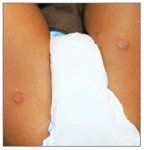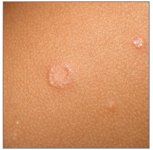Case: A toddler with asymptomatic lesions
A toddler has been covered with ringed plaques for two months resistant to topical antifungal creams.
>> How would you treat him?
>> What's the diagnosis?


Granuloma annulare (GA) is a chronic, usually self-limited asymptomatic granulomatous process most commonly affecting children and young adults, with a female predominance of 2:1. The idiopathic condition is thought to be a type of hypersensitivity reaction. GA lesions range from papules with a central dell to ring-shaped plaques, and may be skin-colored, violaceous, or erythematous. Lesions are typically found on the trunk and dorsum of the extremities. With GA in otherwise healthy children, there is no increase in other types of inflammatory disorders or comorbidities later in life.1-3
There are four recognized clinical variants of GA: localized, generalized, unusual, and subcutaneous. The localized form, which is the most common, is characterized by 0.5- to 5-cm papules and annular plaques. Lesions most commonly occur on the distal extremities, and usually resolve without treatment in one to two years.
In generalized GA, individual plaques are similar to the localized variant but 10 or more lesions are present, and any site can be involved. The eruption usually persists for two to four years. The papules and plaques in the unusual perforating variant develop a thick central scale, and may ulcerate. Lesions may also be associated with pain and pruritis.1,2 However, unlike in adults, the disseminated eruption is not usually associated with underlying systemic disease like diabetes mellitus.
In subcutaneous GA, lesions most commonly develop on the buttocks, lower extremities, hands, and scalp, and may be associated with more typical superficial lesions.1,4 These deep-seated asymptomatic nodules usually resolve without scarring, and are also not associated with systemic disease.
Differential diagnosis
Superficial lesions may be mistaken for tinea capitis, pityriasis rosea, atopic dermatitis, and other eczematous processes. However, the plaques in GA typically involve the dermis, and do not exhibit overlying scale or other epidermal changes.
The differential diagnosis of subcutaneous lesions includes other benign and malignant nodules. However, history and physical findings usually exclude most of these disorders.
The annular configuration of plaques may suggest tinea. However, dermatophyte infections usually demonstrate epidermal changes. A potassium hydroxide preparation and fungal culture, if necessary, will exclude tinea. Although the diagnosis of GA can usually be made clinically, it can be confirmed by characteristic histologic findings on skin biopsy.1,2,5
Treatment
Treatment for localized GA is not required, because the eruption is typically asymptomatic and resolution occurs without intervention. Topical and intralesional corticosteroids may help with the cosmetic appearance, but may result in scarring.2
Our patient
Fungal culture of our patient's lesions was negative. The parents were reassured of the innocent and self-limited course of GA, and a follow-up examination was scheduled for four months.
MR. THERRIEN is a medical student at the University of Mississippi Medical Center, Jackson, Miss.
DR. SOREY is an Associate Professor of Pediatrics at the University Of Mississippi Medical Center.
The authors and section editor have nothing to disclose in regard to affiliations with, or financial interests in, any organization that may have an interest in any part of this article.
Vignettes are based on real cases which have been modified to allow the authors and editor to focus on key teaching points. Images may also be edited or substituted for teaching purposes.
References
1. Wolf K, Johnson RA, Suurmond D: Granuloma annulare. Fitzpatrick's Color Atlas and Synopsis of Clinical Dermatology New York: McGraw Hill, 2005.
2. Cyr PR: Diagnosis and management of granuloma annulare. Am Fam Physician, 2006;74,1729
3. Dahl MV: Granuloma annulare: Long-term follow-up. Arch Dermatol 2007;143,946
4. Grogg KL, Nascimento AG: Subcutaneous granuloma annulare in childhood: Clinicopathologic features in 34 cases. Pediatrics 2001;107(3),e42
5. Cohen BA, Wang J: Balancing the scales. Cont Ped 2008;25(2):28